Gerry Feehan
A glorious afternoon among the vineyards by Gerry Feehan

A glorious afternoon among the vineyards
One of the keys to enjoyable travel — and recovery from a seven-hour jet-lag hangover — is to give oneself time to acclimate. And what better place to do that than in the City of Lights?
On tap was a week-long bike ‘n barge in southwest France. But rather than simply change planes at Charles De Gaulle airport and continue on to Bordeaux, we deplaned, shuttled into the French capital and gayly strolled the streets of Paris for a couple of days.


Fun in the streets of gay Paris
Paris, like many of the world’s great cities, is a pleasure to walk. From our hotel in the Latin Quarter, it was an easy saunter along the left bank of the Seine to the Eiffel Tower. En route, we passed two of the world’s great museums, the Louvre and the Musée d’Orsay. Famished after a half-hour en pied, we stopped at a quiet brasserie for escargot and steak tartare. Fun fact: raw beef is best washed down with a heaping helping of Pernod. After lunch we wandered on and were soon gazing up at the Arc de Triomphe and the crazy traffic on the Champs-Elysees. On the return traipse we followed the river’s course to Notre Dame Cathedral where we climbed the narrow spiral staircase to the church’s wooden bell tower for the magnifique view of Paris. We were amongst the last to do so. A couple of months later, the 800- year-old edifice was gutted by fire.
After our relaxing stay in La Cité, we boarded the train at Gare Montparnasse, well-rested and physically and mentally prepared for the formidable task ahead: seven laid-back days of pedalling through the serene back roads of southwest France, coupled with the burden of sampling fine Bordeaux wines.

The trip from Paris to Bordeaux is over 500km, but when travelling by rail at over 300km/h, the journey is over in a flash. At the station in Bordeaux we transferred for the short run into Libourne, a sleepy little village on the Dordogne River, where we boarded our vessel, the aptly named MS Bordeaux. The ship was originally commissioned in the 1920s as a Rhinetuger, hauling heavy burdens on the Rhine River. The old gal went through a number of iterations over the decades before being converted into a passenger vessel. The boat has 49 cabins, but there were only 23 guests, so we became friends with everyone on board — crew and clientele alike.
It was a cozy, intimate experience.

On the weeklong voyage, we drifted slowly down the Dordogne toward the Bay of Biscay. When we reached the wide Gironde estuary we made a u-turn and rode the incoming tide up the Garonne River to Castets-en-Dorthe where we were to disembark. It was late fall, the ship’s last sailing of the season. The weather was ideal. The autumn hues of southern France were on full display.
Each morning, after a fine petit dejeuner, we stuffed our panniers with a picnic lunch of oven-fresh baguettes, pate, brie, fruit — and a world of pastries. Then we’d roll down the gangplank and hit the bucolic road. Each route was unique and scenic.
A GPS mounted to the handlebars kept us on track, ensuring we didn’t turn a la gauche when we should have gone a la droit.


We pedalled past orchards of ripening grapes, waving at the friendly vendangeurs hand-picking the last sweet remains of the year’s vintage. Often the route led us up what looked like a private lane, a path we’d never have taken had not the GPS assured us we were on course. We’d stop and gawk at some enormous ancient stone Château before continuing down the cobbled way.

Fall is hunting season
Despite the season, many of the Châteaux were open for tastings, invariably hosted by a friendly, effusive, fifth-generation proprietor, happy to share the family cellar with a group of foreign geeks in cycling shorts.


Bordeaux boasts some of the most stunning scenery in all of France — and some of its best vintages. That’s saying a lot in a country renowned for le vin. Personally, I turn up my nose at snooty French reds like Cote du Rhone and Burgundy. They’re a little too subtle for my meat-and-potatoes palette. Give me a big beefy Bordeaux any day. And that is what this appellation is all about: deep purple merlots blended with a splash of cabernet sauvignon.
Some of our fellow passengers chose e-bikes to lighten the load, but our group of eight hearty Canucks toughed out the Bordeaux hills with good old-fashioned foot-pedal power. We logged about 50km per day, a distance one could easily cover in a few hours. But, what with stopping to marvel at the glorious views, photograph the panoramic campagne, sip Sauterne and enjoy a leisurely picnic lunch, we managed to stretch every outing into an eight-hour work-day.

Beware of dogs in the fog!
One morning as we meandered down a medieval lane enjoying the ‘douceur de vivre’ a layer of mist descended upon us. This typical morning fog offers perfect growing conditions for Bordeaux’s famous varietals. Suddenly from out of the haze a huge dog, teeth angrily bared, descended on my wife Florence. I shouted but the mongrel continued its malevolent advance, apparently unfamiliar with English profanity. Then I remembered the tip regarding unfriendly curs contained in our pre-trip information pamphlet:
“Continue cycling past the dog. If it persists, a more aggressive approach may be required, in the form of pretending to throw a stone (or in extreme cases actually throwing a stone).”
The animal’s command of English may have been lacking, but it was a quick learner when it came to comprehending the meaning of rock on chien.
That evening, after another glorious dinner on the boat, we retired to the lounge for a digestif. It was the last night of the last sailing of the year and Sebastian, our maîtres d’, cum waiter, cum bartender, was ready to let his hair down. He brazenly lassoed all the female passengers onto the dance floor for a Bacchanalian romp. Overhead, a faux-disco ball twirled as the ladies gyrated and the boat rocked. The men, fatigued from another trying day amongst the Bordeaux vineyards, were content to sip Pastis and chat.

An ebullient Sebastian

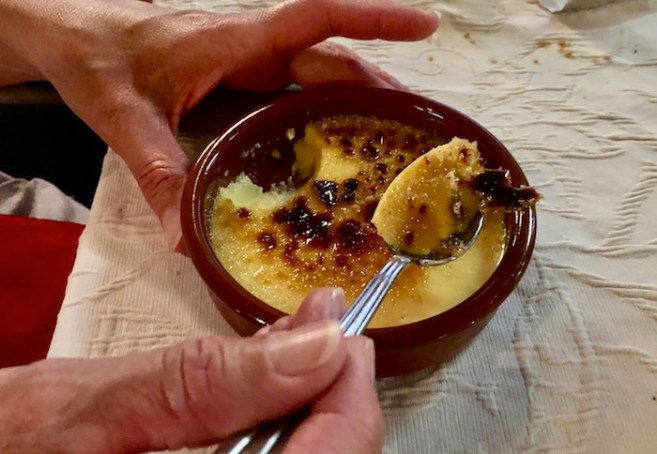
Another fantastique dinner
I quietly slipped into the night air and onto the upper deck. After bidding adieu to my bicyclette and its worn tires, I made my way to our berth and slipped into a dreamless sleep. I needed the rest. In the morning our last arduous adventure would begin: two lazy days of decompressing back in gay Paris.
If you go: www.aquitaine-cruises.com

‘Goodbye Bordeaux’
Gerry Feehan is an award-winning travel writer and photographer. He lives in Kimberley, BC.

Thanks to Kennedy Wealth Management for sponsoring this series. Click on the ads and learn more about this long-term local business.
Gerry Feehan
Abu Simbel
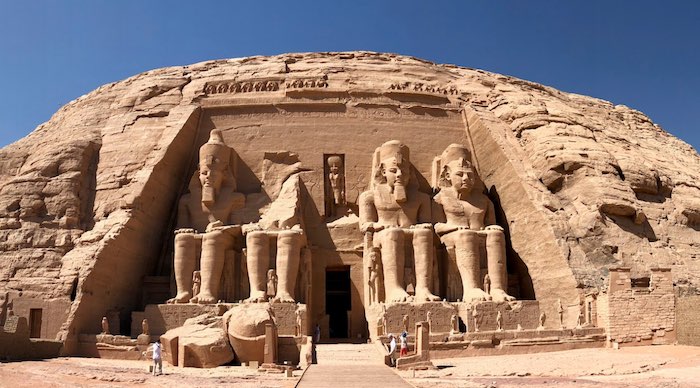
Abu Simbel is a marvel of ancient and modern engineering
I love looking out the window of an airplane at the earth far below, seeing where coast meets water or observing the eroded remains of some ancient formation in the changing light. Alas, the grimy desert sand hadn’t been cleaned from the windows of our EgyptAir jet, so we couldn’t see a thing as we flew over Lake Nasser en route to Abu Simbel. I was hopeful that this lack of attention to detail would not extend to other minor maintenance items, such as ensuring the cabin was pressurized or the fuel tank full.
We had just spent a week on a dahabiya sailboat cruising the Nile River, and after disembarking at Aswan, were headed further south to see one of Egypt’s great
monuments. There are a couple of ways to get to Abu Simbel from Aswan. You can ride a bus for 4 hours through the scorched Sahara Desert, or you can take a plane for the short 45-minute flight.
Opaque windows notwithstanding, I was glad we had chosen travel by air. Abu Simbel is spectacular, but there’s really not much to see except the monument itself and a small adjacent museum. So most tourists, us included, make the return trip in a day. And fortunately we had Sayed Mansour, an Egyptologist, on board. Sayed was there to explain all and clear our pained expressions.
Although it was early November, the intense Nubian sun was almost directly overhead, so Sayed led us to a quiet, shady spot where he began our introduction to
Egyptian history. Abu Simbel is a marvel of engineering — both modern and ancient. The temples were constructed during the reign of Ramses II. Carved from solid rock in a sandstone cliff overlooking the mighty river, these massive twin temples stood sentinel at a menacing bend in the Nile — and served as an intimidating obstacle to would-be invaders — for over 3000 years. But eventually Abu Simbel fell into disuse and succumbed to the inevitable, unrelenting Sahara. The site was nearly swallowed by sand when it was “rediscovered” by European adventurers in the early 19 th century. After years of excavation and restoration, the monuments resumed their original glory.
Then, in the 1960’s, Egyptian president Abdel Nasser decided to construct a new “High Dam” at Aswan. Doing so would create the largest man-made lake in the
world, 5250 sq km of backed-up Nile River. This ambitious project would bring economic benefit to parched Egypt, control the unpredictable annual Nile flood and also supply hydroelectric power to a poor, under-developed country. With the dam, the lights would go on in most Egyptian villages for the first time. But there were also a couple of drawbacks, which were conveniently swept under the water carpet by the government. The new reservoir would displace the local Nubian population whose forbearers had farmed the fertile banks of the Nile River for millennia. And many of Egypt’s greatest monuments and tombs would be forever submerged beneath the deep new basin — Abu Simbel included. But the government proceeded with the dam, monuments be damned.
Only after the water began to rise did an international team of archaeologists, scientists — and an army of labourers — begin the process of preserving these
colossal wonders. In an urgent race against the rising tide, the temples of Abu Simbel were surgically sliced into gigantic pieces, transported up the bank to safety and reassembled. The process was remarkable, a feat of engineering genius. And today the twin edifices, honouring Ramses and his wife Nefertari remain, gigantic, imperious and intact. But instead of overlooking a daunting corner of the Nile, this UNESCO World Heritage site now stands guard over a vast shimmering lake.
Sayed led us into the courtyard from our shady refuge and pointed to the four giant Colossi that decorate the exterior façade of the main temple. These statues of
Ramses were sculpted directly from Nile bedrock and sat stonily observing the river for 33 centuries. It was brutally hot under the direct sun. I was grateful for the new hat I had just acquired from a gullible street merchant. Poor fellow didn’t know what hit him. He started out demanding $40, but after a prolonged and brilliant negotiating session, I closed the deal for a trifling $36. It was difficult to hold back a grin as I sauntered away sporting my new fedora — although the thing did fall apart a couple of days later.
Sayed walked us toward the sacred heart of the shrine and lowered his voice. Like all Egyptians, Sayed’s native tongue is Arabic. But, oddly, his otherwise perfect English betrayed a slight cockney accent. (Sayed later disclosed that he had spent a couple of years working in an East London parts factory.) He showed us how the great hypostyle hall of the temple’s interior is supported by eight enormous pillars honouring Osiris, god of the underworld.

Exploring the inner temple

Nefertari
Sayed then left us to our devices. There were no other tourists. We had this incredible place to ourselves. In the dim light, we scampered amongst the sculptures
and sarcophagi, wandering, hiding and giggling as we explored the interior and its side chambers. At the far end lay the “the holiest of holies” a room whose walls were adorned with ornate carvings honouring the great Pharaoh’s victories — and offering tribute to the gods that made Ramses’ triumphs possible.
Exterior photographs of Abu Simbel are permitted, but pictures from within the sanctuary are verboten — a rule strictly enforced by the vigilant temple guardians — unless you offer a little baksheesh… in which case you can snap away to your heart’s content. Palms suitably greased, the caretakers are happy to pose with you in front of a hidden hieroglyph or a forbidden frieze, notwithstanding the stern glare of Ramses looking down from above.

A little baksheesh is key to holding the key
After our brief few hours at Abu Simbel, we hopped back on the plane. The panes weren’t any clearer but, acknowledging that there really wasn’t much to see in the Sahara — and that dirty airplane windows are not really a bona fide safety concern — I took time on the short flight to relax and bone up on Ramses the Great, whose mummified body awaited us at the Egyptian Museum in Cairo.
Exodus Travel skilfully handled every detail of our Egypt adventure: www.exodustravels.com/
Gerry Feehan is an award-winning travel writer and photographer. He lives in Kimberley, BC.

Thanks to Kennedy Wealth Management for sponsoring this series. Click on the ads and learn more about this long-term local business.
Gerry Feehan
Cairo – Al-Qahirah
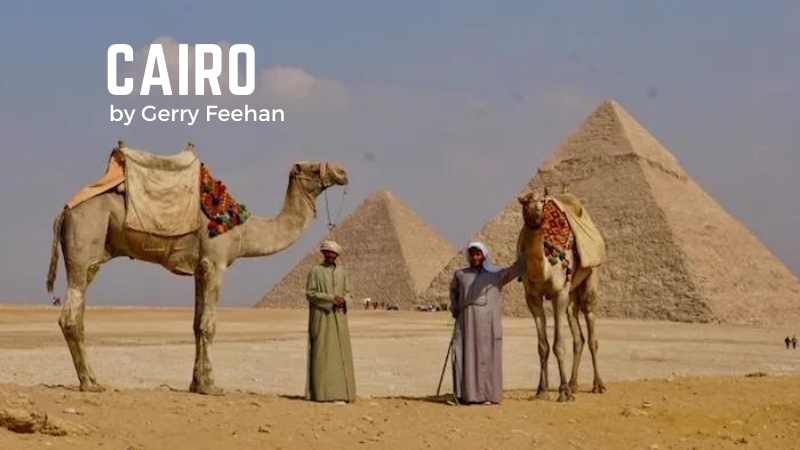
The Pyramids of Giza
The first thing one notices upon arrival in Egypt is the intense level of security. I was screened once, scanned twice and patted down thrice between the time we landed at the airport and when we finally stepped out into the muggy Cairo evening. At our hotel the scrutiny continued with one last investigation of our luggage in the lobby. Although Egyptian security is abundant in quantity, the quality is questionable. The airport x-ray fellow, examining the egg shaker in my ukulele case, sternly demanded, “This, this, open this.” When I innocently shook the little plastic thing to demonstrate its impermeability he recoiled in horror, but then observed it with fascination and called over his supervisor. Thus began an animated, impromptu percussion session. As for the ukulele, it was confiscated at hotel check-in and imprisoned in the coat check for the duration of our Cairo stay. The reasons proffered for the seizure of this innocuous little instrument ranged from “safety purposes” to “forbidden entertainment”. When, after a very long day, we finally collapsed exhausted into bed, I was shaken — but did not stir.
Al-Qahirah has 20 million inhabitants, all squeezed into a thin green strip along the Nile River. Fading infrastructure and an exponential growth in vehicles have contributed to its well-deserved reputation as one of the world’s most traffic-congested cities. The 20km trip from our hotel in the city center, to the Great Pyramid of Cheops at Giza across the river, took nearly two hours. The driver smiled, “Very good, not rush hour.”
Our entrance fee for the Giza site was prepaid but we elected to fork out the extra Egyptian pounds to gain access to the interior of the Great Pyramid. Despite the up-charge — and the narrow, dark, claustrophobic climb – the reward, standing in Cheop’s eternal resting place, a crypt hidden deep inside the pyramid, was well worth it. We also chose to stay after sunset, dine al fresco in the warm Egyptian evening, and watch the celebrated ‘sound and light’ performance. The show was good. The food was marginal. Our waiter’s name was Fahid. Like many devout Muslim men, he sported a zabiba, or prayer bump, a callus developed on the forehead from years of prostration. Unfortunately throughout the event Fahid hovered over us, attentive to the point of irritation, blocking our view of the spectacle while constantly snapping fingers at his nervous underlings. The ‘son et lumière’ show was a little corny, but it’s pretty cool to see a trio of 4500-year-old pyramids – and the adjoining Great Sphinx — illuminated by 21 st century technology.

The Great Sphinx

Giza at nightThe next night our group of six Canucks attended an Egyptian cooking class. Our ebullient hostess was Anhar, (‘the River’ in Arabic). Encouraged by her contagious enthusiasm, we whipped up a nice tabouli salad, spicy chicken orzo soup and eggplant moussaka. We finished up with homemade baklava. Throughout the evening, Anhar quizzed us about the ingredients, the herbs and spices, their origins and proper method of preparation. Anyone who answered correctly was rewarded with her approving nod and a polite clap. Soon a contest ensued. Incorrect answers resulted in a loud communal ‘bzzzt’ — like the sound ending a hockey game. It’s not polite to blow one’s own horn, but the Feehan contingent acquitted themselves quite nicely. If I still had her email, Anhar could confirm this.
Cairo was not the highlight of our three-week Egyptian holiday, but a visit to the capital is mandatory. First there’s the incredible Pyramids. But as well there’s the Egyptian Museum that houses the world’s largest collection of Pharaonic antiquities including the golden finery of King Tutankhamen and the mummified remains of Ramses the Great. Ramses’ hair is rust coloured and thinning a little, but overall he looks pretty good for a guy entering his 34 th century.

Ramses the Great

Then there’s Khan el-Khalili, the old souk or Islamic bazaar. We strolled its ancient streets and narrow meandering alleyways, continually set upon by indefatigable street hawkers. “La shukraan, no thanks,” we repeated ineffectually a thousand times. The souk’s cafes were jammed. A soccer match was on. The ‘beautiful game’ is huge in Egypt. Men and women sat, eyes glued to the screen, sipping tea and inhaling hubbly bubbly.

The Old Souk Bazaar

Selfies, Souk style
An aside. When traveling in Egypt, be sure to carry some loose change for the hammam (el baño for those of you who’ve been to Mexico). At every hotel, restaurant, museum and temple — even at the humblest rural commode — an attendant vigilantly guards the lavatory. And have small bills for the requisite baksheesh. You’re not getting change.
After our evening in the souk we had an early call. Our guide Sayed Mansour met us at 6am in the hotel lobby. “Yella, yella. Hurry, let’s go,” he said. “Ana mish bahasir – I’m not joking.” “Afwan,” we said. “No problem,” and jumped into the van. As we pulled away from the curb Sayed began the day’s tutorial, reciting a poem by Percy Blythe Shelly:
I met a traveller from an antique land,
Who said—“Two vast and trunkless legs of stone
Stand in the desert. . . . My name is Ozymandias, King of Kings;
Look on my Works, ye Mighty, and despair!”
And we were off, through the desert, to Alexandria. Founded by Alexander the Great in 332 BC, Egypt’s ancient capital was built on the Nile delta, where the world’s longest river meets the Mediterranean Sea. The day was a bit of a bust. The city was once renowned for its magnificent library and the famed Lighthouse of Alexandria. But the former burnt down shortly after Christ was born and the latter — one of the original seven wonders of the ancient world – toppled into the sea a thousand years ago. Absent some interesting architecture, a nice view of the sea from the Citadel — and Sayed’s entertaining commentary — Alexandria wasn’t really worth the long day trip. Besides, we needed to get back to Cairo and pack our swimwear. Sharm el Sheikh and the warm waters of the Red Sea were next up on the Egyptian agenda.

Gerry with some Egyptian admirers
Exodus Travel skilfully handled every detail of our trip: www.exodustravels.com And, if you’re thinking of visiting Egypt, I can suggest a nice itinerary. No sense reinventing the pyramid: [email protected]
Gerry Feehan is an award-winning travel writer and photographer. He lives in Kimberley, BC.

Thanks to Kennedy Wealth Management for sponsoring this series. Click on the ads and learn more about this long-term local business.
-

 Business2 days ago
Business2 days agoCBC’s business model is trapped in a very dark place
-
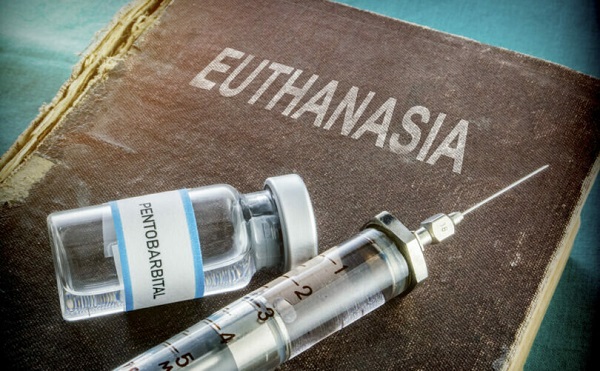
 Alberta2 days ago
Alberta2 days agoAlberta government announces review of Trudeau’s euthanasia regime
-
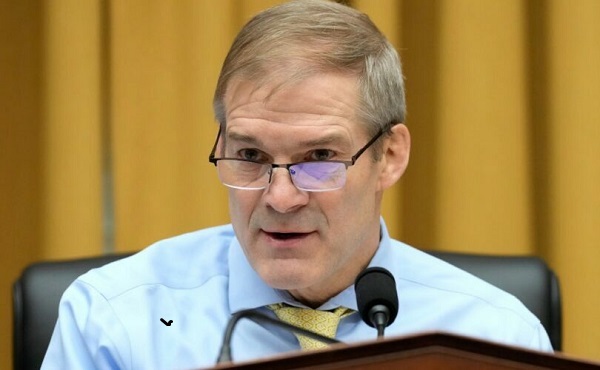
 Censorship Industrial Complex2 days ago
Censorship Industrial Complex2 days agoCongressional investigation into authors of ‘Disinformation Dozen’ intensifies
-

 Alberta1 day ago
Alberta1 day agoAlberta fiscal update: second quarter is outstanding, challenges ahead
-

 Business1 day ago
Business1 day agoTrump’s government efficiency department plans to cut $500 Billion in unauthorized expenditures, including funding for Planned Parenthood
-
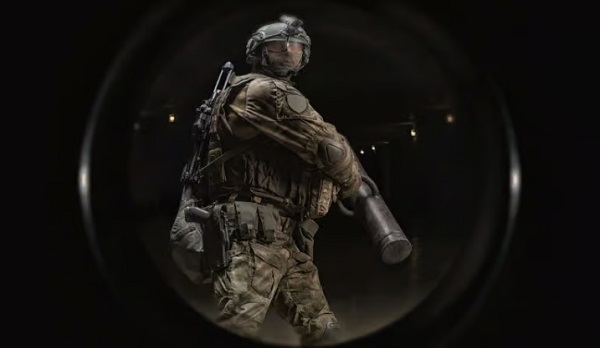
 Brownstone Institute18 hours ago
Brownstone Institute18 hours agoFirst Amendment Blues
-
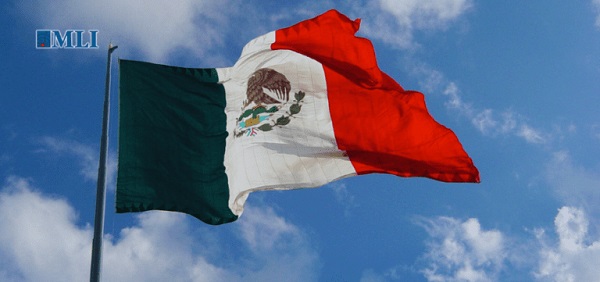
 Crime1 day ago
Crime1 day agoMexican cartels are a direct threat to Canada’s public safety, and the future of North American trade
-

 Business21 hours ago
Business21 hours agoDEI gone?: GOP lawmakers prep to clean house in federal government







